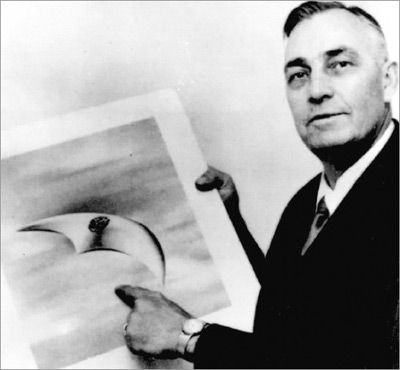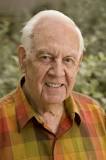By Charles Lear
 From the days of the earliest citizen UFO investigators, metals associated with UFO reports have been held up as evidence for extraterrestrial visitation. Labs have been employed in testing and claims have been made that the results support a non-earthly origin for the material in question. While some of these claims have been dismissed, others continue to be debated.
From the days of the earliest citizen UFO investigators, metals associated with UFO reports have been held up as evidence for extraterrestrial visitation. Labs have been employed in testing and claims have been made that the results support a non-earthly origin for the material in question. While some of these claims have been dismissed, others continue to be debated.
The first modern UFO era citizen investigator was Kenneth Arnold, who was also the first modern era UFO witness. Arnold had seen a fleet of UFOs while flying near Mt. Rainier on June 24, 1947. Arnold was offered an assignment by publisher, Ray Palmer, who was looking for a good story for the premier issue of his new venture, Fate magazine. Palmer had received a letter describing a sighting near Maury Island, off the coast of Tacoma, Washington. Six donut-shaped craft were reported, one of which seemed to be having difficulties. It discharged hot material that allegedly injured the witness’s son and killed his dog. Palmer asked Arnold to look into the story, and Arnold asked for $200. Palmer wired him the money and Arnold became the world’s first privately funded UFO investigator.
 Arnold went to Tacoma to interview the witness, Harold Dahl, and his business partner, Fred Crisman. He quickly found himself entangled in a dubious case that he felt ill equipped to evaluate. He called a friend, E. J. Smith, who was another pilot UFO witness, and then brought in two Army Air Force intelligence officers. The intelligence officers had investigated Arnold’s sighting, and they were happy to help out.
Arnold went to Tacoma to interview the witness, Harold Dahl, and his business partner, Fred Crisman. He quickly found himself entangled in a dubious case that he felt ill equipped to evaluate. He called a friend, E. J. Smith, who was another pilot UFO witness, and then brought in two Army Air Force intelligence officers. The intelligence officers had investigated Arnold’s sighting, and they were happy to help out.
The officers were unimpressed by the story but took some of the material with them as they left. They flew back late at night in order to be present for the celebration of the creation of the Air Force, and the plane crashed, killing both of them. Newspaper stories appeared saying that the officers were carrying material from a flying saucer, and conspiracy theories followed. Material recovered from the crash site resembling the described material can be seen in detail in a video posted on youtube. The material looks very much like lava and has what look like quartz crystals. Material from Maury Island was identified as “slag from the production of steel” in tests run at Chicago University in 1947, at the behest of Ray Palmer.
On August 20, 1952, a fiery object crashed through a 20 gauge metal sign in New Haven, Connecticut, and continued on. Left behind was trace evidence in the form of a jagged hole and embedded metal fragments. An investigator for the International Flying Saucer Bureau, August C. Roberts, had been up there previously and invited James Moseley to come along and help him continue his investigation. Moseley would later become notorious for his publication, Saucer Smear.
They interviewed witnesses and talked to a local investigator, Joseph Barbieri. Barbieri had taken the damaged section of the sign, removed some of the embedded fragments, and sent them to the newly formed Aerial Phenomena Research Organization to have them analyzed. APRO’s founder, Coral Lorenzen, sent the fragments to a Milwaukee lab and they were identified as copper. Roberts and Moseley acquired fragments from the sign’s wood support. The results of the analysis Roberts arranged also identified the fragments as copper with the additional detail that it was high grade. There was nothing to indicate that it was extraterrestrial.
 APRO came into possession of more metal fragments in 1957. The metal was first mentioned in the Rio de Janeiro newspaper El Globo. An article headlined, “Un Fragmento De Disco-Voador!,” written by society columnist Ibrahim Sued and published Sept. 14, 1957, describes an interesting letter he received. A reader, wishing to give Sued a “scoop,” told the story of seeing a flying disc explode near Ubatuba, Brazil. Along with his letter, the writer included samples of metal he claimed to have retrieved.
APRO came into possession of more metal fragments in 1957. The metal was first mentioned in the Rio de Janeiro newspaper El Globo. An article headlined, “Un Fragmento De Disco-Voador!,” written by society columnist Ibrahim Sued and published Sept. 14, 1957, describes an interesting letter he received. A reader, wishing to give Sued a “scoop,” told the story of seeing a flying disc explode near Ubatuba, Brazil. Along with his letter, the writer included samples of metal he claimed to have retrieved.
APRO’s man in Brazil was Dr. Olavo Fontes. Fontes read the article and arranged to visit Sued. He examined the samples, which he described as three pieces of dull grey metal. Fontes was given the metal, and he wrote a report for APRO. He brought the pieces to the Mineral Production Laboratory in Rio de Janeiro. One piece was broken into several parts. The lab kept two of them and Fontes took the rest.
 The metal was re-examined by Peter A. Sturrock, and he published the results in an article titled “Composition Analysis of the Brazilian Magnesium,” published in the Journal of Scientific Exploration, Vol. 15, No. 1, pp. 69-95, 2001. In the article, Sturrock provides the history of the metal’s origin and the various analyses done to determine its composition.
The metal was re-examined by Peter A. Sturrock, and he published the results in an article titled “Composition Analysis of the Brazilian Magnesium,” published in the Journal of Scientific Exploration, Vol. 15, No. 1, pp. 69-95, 2001. In the article, Sturrock provides the history of the metal’s origin and the various analyses done to determine its composition.
The metal was first analyzed at the Mineral Production Laboratory by Dr. Luisa Maria A. Barboso using a Hilger mass spectrograph. Barbosa’s report states “The spectrographic analysis showed the presence of magnesium (Mg) of a high degree of purity and absence of any other metallic element.” Fontes requested another analysis by the same lab and another scientist, Elson Texeira, reported the metal was magnesium that was “absolutely pure.” This statement was held up as proof by Fontes and APRO that the metal was of extraterrestrial origin, as no foundry on Earth was capable of producing 100% pure magnesium.
An additional statement in Texeira’s report refutes the extraterrestrial hypothesis for the metal’s origin:
A comparison was made between the spectrum of the unknown metal and that of a chempur [sic] magnesium salt. It showed clearly that they were identical–in fact, all their spectrum lines corresponded with each other. This demonstrated the extreme purity of the sample.
That means that Texeira was comparing the mystery metal with an earthly sample of “chemically pure” magnesium. The two had identical spectrums, thus the mystery metal could very well have had an earthly origin. The odd part is that Texeira also stated that no impurities were detected in the carbon rod used as an electrode during the analysis when there should have been. Sturrock speculates that this might be an indication that the Hilger mass spectrograph had malfunctioned but questions the likelihood that it did so during both analyses.
Fontes sent pieces of sample 1 to both the Brazilian Army and Navy. The pieces were not returned and he never received any information about analyses that might have been done. Coral Lorenzen described what might have been a follow up by the Brazilian military in the form of a personal visit to Fontes in her 1962 book, “The Great Flying Saucer Hoax.” According to her, in 1958, Fontes was “visited by two members of a Brazilian intelligence agency” who “made veiled threats” in order to dissuade him from continuing his investigation. They asked him to give them all his notes and the remaining samples and he refused. Conspiracy theorists might be interested to know that Fontes died of cancer in 1968 at the age of 44. This is not mentioned in Sturrock’s article.
Fontes gave the remaining samples to APRO, and in 1961, they sent a piece of one of them to the Air Force. The analyst there burned up the sample without obtaining an exposed plate. Another sample was requested, and APRO declined. Sturrock doesn’t make clear that this was sample 1 but does state that APRO was ultimately left with only samples 2 and 3. Pieces of sample 2 were sent to the Dow Chemical Corporation and the results of that analysis show the presence of calcium and barium.
In 1967, the University of Colorado was engaged in an Air Force Funded UFO study headed by Dr. Edward U. Condon. The study team was interested in examining the metal and analysis was assigned to Dr. Roy Craig. Craig visited Dow where he was given a specimen of triply sublimed magnesium for comparison with the Ubatuba samples. Craig’s results, printed in the 1969 “Condon Report” show that the Ubatuba magnesium was not 100% pure.
Sturrock became interested in the metal after writing an evaluation of the Condon Report in the same journal (Sturrock, 1987). He arranged with the Lorenzens to get the material tested and the results showed no difference in isotopic ratio to that of terrestrial magnesium. The Lorenzens transferred ownership of the remaining material to Sturrock, but the samples were out on loan, and Sturrock had to track them down. One sample turned out to be lost, and he was left with one remaining sample. After extensive tests, Sturrock found no reason to believe the magnesium was of extraterrestrial origin. The original witness and source for the material was never identified, so even its association with a UFO is suspect. Unfortunately, the metal originally reported to have been pure came from sample 1, so there is enough doubt that believers still hold out for the possibility that the Ubatuba metal is extraterrestrial.
There’s much more to it than that though….
1. Sturrock reported that he tested every kind of industrial 99% Magnesium produced at the time, including Russian ones – none showed traces of Strontium, who in every sample was shown to be around 700ppm. He also reported traces of titanium, chromium, iron, cobalt, selenium, strontium, yttrium, niobium, palladium and barium, all which may point toward an origin in a technological device or devices. As far as Sturrock researched, there was no creator at the time which used any technology that could cause the amount of Strontium found in the sample.
2. Isotope Analysis did find that it was on the same “line” as the isotope proportions of Earth, (isotope 26/isotope 24 x isotope25/isotope24), although lower than every other industrial sample of the time. However it needs to be NOTED WITH EMPHASIS that every time Magnesium goes through sublimation, they move LOWER in the 26/24 x 25/24 proportion, AND with every sublimation, the Magnesium tends to be purified (in the normal processes).
The Brazilian magnesium, however, actually has the lowest 26/24×25/24 ratio than every other industrial sample of the period, and achieves that lowest position (which in theory could be the result of multiples sublimations) while still having significant amounts of Calcium and Strontium and Barium within it, which would have all been gone at this level of sublimation!